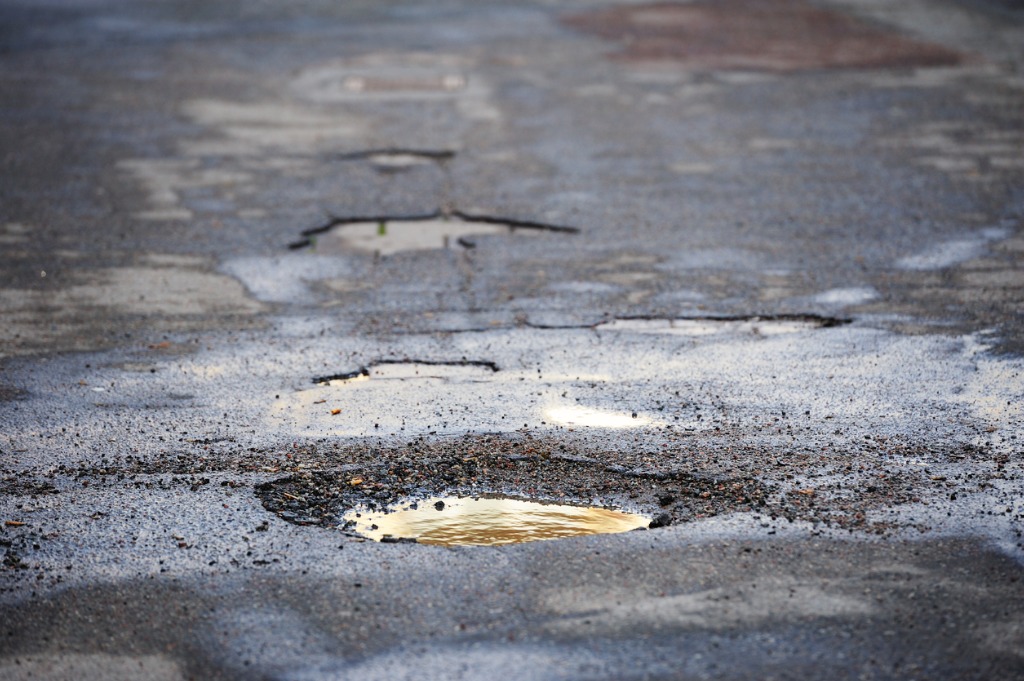Asphalt is a common material for paving surfaces. It’s strong, versatile, and affordable. Although your new blacktop should last for years, it is vulnerable to heavy traffic and construction or even strong storms and winter weather.
Asphalt raveling is the disintegration of the top of your asphalt. You might notice it when you see loose rocks or broken pieces on your pavement. It looks like it’s only the top layer of the asphalt that is breaking down, but the foundation of the blacktop is also being compromised. Trust us; the problem will only get worse. As the asphalt continues to decay, the entire surface becomes vulnerable to more raveling.
Asphalt raveling will cause your blacktop to look ugly and old, which can hurt your reputation, and eventually, your asphalt will become unsafe. Visitors can trip and injure themselves in your parking lot, and water can begin to pool on the asphalt’s surface, causing hydroplaning. The raveling will continue to break apart the asphalt, creating bigger potholes in your driveway or parking lot.
What Causes Asphalt Raveling?
Asphalt is a durable material, but it will disintegrate over time. The sun causes asphalt to break down, and rain and ice weaken the bonds between the top layer of aggregate and the foundation. After a few years, the top layer may have cracks or potholes simply due to the weather. When combined with other factors that can damage your asphalt, including the following, you may see your asphalt begin to ravel even sooner.
- Improper installation – asphalt cannot be installed when it’s too humid, when there is a lot of moisture in the air, or when the temperatures are too low.
- Inadequate compaction – asphalt requires a high density at installation at the right temperatures.
- Snowplows and heavy equipment – certain types of traffic, such as snow plows or studded tires, can dislodge asphalt.
- Vehicle fluids – leaking oil, antifreeze, and gasoline can make the top surface disintegrate.
- Poorly made aggregate mix – if the aggregate mix has a dust coating, the binder may not be able to bond with the aggregate effectively.
- High traffic – heavy wear and tear can break down asphalt prematurely.
Age is the final factor to consider; older pavements are more vulnerable to raveling.
 How to Prevent Asphalt Raveling
How to Prevent Asphalt Raveling
You should keep your asphalt clean of debris and vehicle fluids to prevent damage to the pavement. Regular sealcoating of your asphalt is one of the best ways to prevent asphalt damaging. You should have your asphalt resealed every two to three years to defend against the elements, traffic, and other problems; it can double the life of your asphalt.
Use high-quality products to slow the oxidation and raveling processes. Before sealcoating, make sure to fix any small problems in the asphalt. Have the asphalt cleaned well before applying the coating. Ask about any warranties on the sealcoating to make sure the product protects as promised.
If you do have a snow plow service, make sure you use a reputable contractor who knows how to prevent damage to your pavement. Raising the snow plow blade just a little bit off the ground can prevent damage. Find a way to lay out a track that makes curbs and entranceways visible to drivers before the snow blows. When the snow season is over, check for any damage that needs to be repaired before the spring rains set in.
We also recommend having a professional inspect your pavement every year to find small problems that you might not notice on your own. Proactive maintenance is the best way to avoid major damage.
Repairing Asphalt Raveling
Repairing raveled asphalt depends on two things. First, you have to look at the severity of the damage. Second, the root cause should be identified.
Localized repairs may do the trick if the raveling is occurring in small places, a professional contractor may be able to patch the problem before sealcoating it.
However, you may require extensive repairs if the raveling is severe or throughout the entire pavement, it may require removal and replacement to actually fix the problem.
In some cases, an overlay may be able to be applied, but it depends on the cause of the raveling. If the cause is heavy traffic, the overlay may solve the problem. If the installation of the asphalt was improper or the damage is from many years of non-maintenance, the entire parking lot may need to be resurfaced.
Homeowners often try to fix their own driveways when they notice asphalt raveling, but we recommend talking to a professional who can help you solve the problem and mitigate future damage. For commercial parking lots and sports surfaces, you should work with a professional contractor who can make sure that your surface is safe and durable for its intended use.
Protect Your Investment
McConnell & Associates was the first paving contractor to bring asphalt sealcoating to the area. Our team knows how to help you extend the life of your pavement through multiple services, including pothole repairs, crack filling, milling, and overlays. We use premium products and pay attention to details to keep your project on budget and on schedule.
When you contact us for your asphalt installation, repairs, or replacement, you won’t need to use multiple contractors because we take care of everything from start to finish, including striping and marking. Our team can help you create a maintenance program that minimizes disruption to your organization and keeps your pavement looking its best all year long.
Since 1965, McConnell & Associates has been providing asphalt services to business owners, apartment owners, and facility managers across Kansas and Missouri. We install, resurface, and restore sidewalks, curbs, parking lots, and sports surfaces. Schedule an appointment with our expert team to get an estimate on your project.


 How to Prevent Asphalt Raveling
How to Prevent Asphalt Raveling.png)


